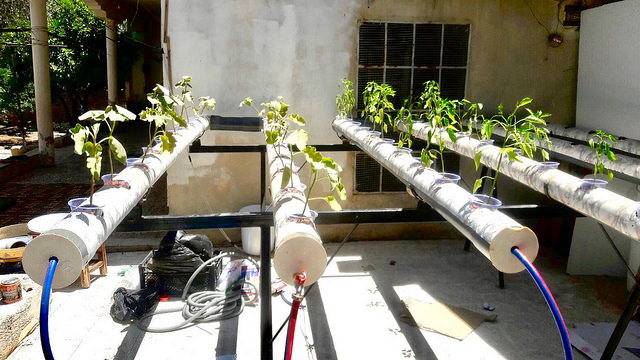Nutrient Film Technique, continued
This is page 8 in our twelve page series on nutrient film technique. Click any of the below pages to jump to that page.
Page 1 Page 2 Page 3 Page 4 Page 5 Page 6 Page 7 Page 8 Page 9 Page 10 Page 11 Page 12

A homemade system with young tomato plants. Note that this particular system has plenty of space between channels for the mature plants.
Do It Yourself Potential in Nutrient Film Technique Systems
Nutrient film technique systems can definitely be constructed at home from a variety of materials; we’ve already discussed some of those basics. Instead of detailing a variety of potential setups, I’ll focus here on some important caveats that need to be front and center in any DIY project.
The first caveat is the issue of spacing. There’s actually two different spacing issues. The first is how much space to allow between net pots within a single channel. That separation will be determined by the size of the plant at maturity and/or harvest, and can vary greatly. For instance, salad plants intended to be harvested at 8 weeks of age will be relatively small, and plants could be planted within the channel anywhere between 6” and 12” apart. Determinate chili plants would need quite a bit more space, say 16” between plants. This would allow for their branching habits, and provide adequate air movement between leaves and between plants. Tomatoes and other large vining plants would need even more space, easily 24” between plants, to provide for mature canopy size. So a careful consideration of plant size must come first.
The second spacing issue is how much space to allow between channels. If your system is going to be small, you might have only one channel, at which point this might not be a consideration. Any NFT system composed of two or more channels will need to consider how much space to allow between them. As we saw above, mature plant size is one concern. A second concern is how human beings will work with the plants. This can be accomplished in a variety of ways. Several very small channels can be spaced only a few inches apart for confined plants like lettuce. A person can reach across those rows and harvest all of them without any space between them. However, a row of tomatoes is an entirely different consideration. A person can’t lean through one tall wall of tomatoes to harvest the next wall over. So the channels would need to have enough space between them to allow for both the human harvester, along with whatever sort of basket or cart he or she will be using to harvest the fruits.
A variation on the above is that sometimes a large crop, say lettuce, will be grown with many channels only a few inches apart from each other. This layout can be seen clearly in many of the photos of commercial NFT systems. The plants are planted, grown and raised as a large batch, and harvested all at once. In between, the plants are literally “out of reach” of human workers because there is so little space between channels. This approach makes the most of available floor space, which may be costly enough that as many plants as possible need to be growing at any given time. However, this means that any problems with disease, flooding, drying out or pest control need to be ironed out in advance because growers physically won’t be able to reach plants once they’ve started growing. A word of caution is to either duplicate a known system with known performance, to minimize the potential for problems, or take the time to build and experiment with a small-scale home-grown system before stacking channels so closely together.
Back Next
Click on any of the below links to jump to that page.
Page 1 Page 2 Page 3 Page 4 Page 5 Page 6 Page 7 Page 8 Page 9 Page 10 Page 11 Page 12